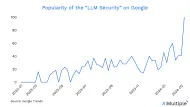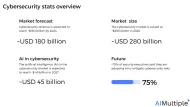Cybersecurity in Healthcare: 7 Challenges & 10 Best Practices in '24
In an increasingly digital world, where digital transformation is prevalent, the healthcare industry has embraced technological advancements to deliver better patient care and streamline operations. However, these innovations also open the door to cybersecurity threats that can compromise patient data and disrupt services.
According to IBM and Ponemon Institute’s 2021 Report, the average cost of a healthcare breach was estimated to be $9 million, more than double the average cost for all industries, which was $4 million.1
This article provides an in-depth explanation of the challenges in the healthcare industry, the importance of cybersecurity in healthcare, and the best practices to protect sensitive information and critical infrastructure backed with data and examples.
What is cybersecurity in healthcare?
Cybersecurity in healthcare refers to protecting:
- sensitive data
- systems
- networks
- medical devices from unauthorized access, manipulation, theft, or destruction.
This involves implementing technology, policies, and procedures to safeguard the confidentiality, integrity, and availability of healthcare information and infrastructure.
However, an analysis shows that cybersecurity in the healthcare industry lags behind security. The growing reliance on technology in such an industry requires it to establish clearly defined cybersecurity measures.2
In Figure 1, you can see some significant statistics regarding cybersecurity in the healthcare industry.
Source: United States Department of Health and Human Services3
Figure 1: HHS 405(d) Aligning Health Care Industry Security Approaches
Why is cybersecurity important in healthcare?
Cybersecurity is paramount in healthcare and data breaches for these reasons:
1) Maintaining patient trust
Patients entrust healthcare providers with their personal and medical information, expecting them to keep it confidential and secure. Due to inadequate data security measures compared to other industries, the healthcare sector is a top target for medical information theft.4 Considering this, a robust cybersecurity framework is essential for maintaining trust and ensuring patients continue to seek necessary medical care without the fear of privacy breaches.
2) Protection of sensitive patient data
A person may change which bank they use or their credit cards, but they cannot change their medical history (e.g. the hospital they went to, previous diseases or sicknesses). Cybercriminals gain immediate and long-term advantages by accessing banking and credit card information and healthcare data.
The U.S. Department of Health and Human Services (HHS) Office for Civil Rights investigated 860 data breaches recorded in the previous 24 months; the investigation revealed that each breach exposed the protected health information (PHI) of at least 500 people.5
Healthcare organizations handle vast amounts of sensitive patient data, including:
- personal information
- medical histories
- and payment details.
Unauthorized access to this data can lead to identity theft, financial fraud, and medical identity theft. The data breach on the insurance giant Anthem’s computer system is one of the most prominent examples of these threats. The breach affected 80 million patients as hackers accessed customers’ names, dates of birth, Social Security numbers, member ID numbers, addresses, and so on.6 Cybersecurity measures like encryption, firewalls, and anti-malware/antivirus software can help protect this data from cybercriminals.
3) Compliance with regulations
Healthcare organizations must adhere to various regulatory standards, such as the Health Insurance Portability and Accountability Act (HIPAA) in the United States.7 These regulations require organizations to implement specific security measures to protect patient data.
Public disclosure must be made on the ORC website for breaches involving 500 or more persons’ unprotected health information. Moreover, each state may impose extra fines and has restrictions pertaining to HIPAA requirements.
For HIPAA violations, the U.S. Department of Justice may additionally impose criminal penalties. Federal fines may vary from $100 to $50,000 for each violation, with penalties of $1 million to $5 million.8 Effective cybersecurity practices enable compliance with these regulations and help avoid penalties or legal action.
4) Safeguarding healthcare infrastructure
Cyber attacks can disrupt healthcare operations by targeting medical devices, IT systems, and critical infrastructure. Such disruptions can endanger patient safety, delay treatments, and may lead to fatalities.
Cybersecurity measures help prevent these attacks, ensuring uninterrupted patient care and the smooth functioning of healthcare facilities.
5) Protecting against financial losses
Cyber attacks can result in significant financial losses for healthcare organizations, including expenses for legal settlements, regulatory fines, and reputational damage. HIPAA violations that include privacy, security, breach reporting, and electronic healthcare transactions are subject to penalties of up to $1.8 million annually.9 Strong cybersecurity practices can minimize these financial risks by preventing data breaches and other cyber incidents.
6)Tackling the growing threat landscape
Cybercriminals are increasingly targeting healthcare organizations due to the high value of patient data and the potential for extortion. To stay ahead of these evolving threats, healthcare providers must invest in robust cybersecurity measures and continually adapt their strategies. Failure to address cybersecurity can have severe consequences for patients and healthcare organizations.
What are the challenges of cybersecurity in healthcare?
Healthcare is a prime target for cybercrime for two reasons: first, it contains a large amount of valuable data, and second, the industry has poor cybersecurity practices.10
Hospitals, clinics, large group practices, and individual providers have been targeted by 72% of recent malicious traffic, viruses, and similar attacks in the healthcare sector.11 Based on these two factors, we see the following cybersecurity challenges in healthcare:
1- Evolving threats
Cybercriminals continuously develop new techniques and technologies to exploit vulnerabilities in healthcare systems, requiring constant vigilance and investment in cybersecurity measures. A healthcare organization would be vulnerable to these evolving threats if they lag behind the newest developments.
2- Legacy systems
Many healthcare organizations rely on outdated medical systems, software, and devices lacking built-in security features or vendor support, making them vulnerable to cyber-attacks. They are called “legacy systems.” Reasons to modernize legacy systems are shown in Figure 2.
Source: Maryville University 12
Figure 2: 7 Reasons For Modernizing Legacy Healthcare Systems
3- Insufficient funding and resources
Limited budgets and resources for cybersecurity initiatives make investing in the necessary technology, personnel, and training to build and maintain a robust security posture challenging. In 2021, 18% of respondents from healthcare organizations in the United States said that the current IT budget in their companies only accounts for one to two percent of the cyber security budget. 22% said that they allocate two to three percent. 13
4- Growing use of connected devices
The growing use of Internet of Things (IoT) devices and connected medical equipment expands the potential attack surface, making it more difficult to secure these devices and ensure their interoperability.
5- Human error
In addition to cyberattacks directed against the weaknesses of information technology (IT) infrastructures, a new type of cyber attack called a social engineering attack aims to exploit human weaknesses.14
Healthcare staff may unintentionally expose systems to cyber risks by:
- using weak passwords
- falling for phishing scams
- mishandling sensitive data.
This is why it is crucial to examine the extent of awareness initiatives and training provided to employees by healthcare organizations.
6- Third-party risk management
Ensuring the cybersecurity of relationships with vendors, suppliers, and partners can be difficult, as each entity may have different security standards and practices.
7- Balancing security and usability
Striking the right balance between security and usability is a significant challenge, as robust cybersecurity measures can sometimes hinder the efficiency and usability of healthcare systems.
How to improve cybersecurity in healthcare?
Improving cybersecurity in healthcare necessitates a multifaceted approach that includes technology, policies, and people, as well as an emphasis on awareness, prevention, and learning (See Figure 3). Here are the top 10 health industry cybersecurity practices.
Source: Snap Comms15
Figure 3: 123 of Cyber Security for Healthcare organizations
Cybersecurity in Healthcare Industry Best Practices
1- Conduct regular risk assessments
Identify potential vulnerabilities, threats, and gaps in security measures by performing periodic risk assessments. This allows organizations to prioritize and allocate resources effectively.
2- Keep systems up to date
Ensure all software, operating systems, and firmware are updated with the latest security patches. Replace outdated or unsupported systems and medical devices with more secure alternatives.
3- Implement strong access controls
Use multi-factor authentication and role-based access controls to limit user access to sensitive data and systems. Regularly review and update user privileges to minimize the risk of unauthorized access.
4- Secure network infrastructure
Deploy firewalls, intrusion prevention systems, and secure communication protocols to protect the organization’s network. Implement network segmentation to isolate sensitive data and systems from potential breaches.
5- Encrypt sensitive data
Protect sensitive data at rest and in transit using encryption technologies. This minimizes the risk of unauthorized access or data breaches.
Read our “Data encryption in Healthcare” article to better understand the usage of data encryption in healthcare.
6- Develop a security-aware culture
Provide regular security awareness training for all staff members, including both clinical and non-clinical personnel. This helps employees recognize, avoid, and report potential cyber threats.
7- Establish incident response and disaster recovery plans
Create well-defined plans for detecting, responding to, and recovering from cybersecurity incidents. Regularly review and update these plans, and conduct practice exercises to ensure preparedness for potential cyber-attacks.
8- Manage third-party risks
Create detailed plans for detecting, responding to, and recovering from cyber incidents. Review and update these plans regularly, and conduct practice exercises to ensure readiness for potential cyber-attacks.
9- Monitor and audit
Monitor the organization’s systems, networks, and devices for potential threats and unusual activity continuously. Conduct regular security audits to assess security measures’ effectiveness and identify improvement areas.
10- Collaborate and share information
Engage with other healthcare organizations, industry groups, and government agencies to share:
- The best practices
- Threat intelligence
- The lessons learned from cyber incidents.
Collaboration can help strengthen the entire healthcare sector’s cybersecurity posture.
If you have further questions, reach us:
External Links
- 1. IBM “Cost of a data breach 2022” 2022
- 2. Kruse, Clemens Scott, et al. “Cybersecurity in Healthcare: A Systematic Review of Modern Threats and Trends” 1 Jani 2017: 1 – 10.
- 3. United States Department of Health and Human Services, “Why Care About Cybersecurity”
- 4. Kruse, Clemens Scott, et al. “Cybersecurity in Healthcare: A Systematic Review of Modern Threats and Trends” 1 Jani 2017: 1 – 10.
- 5. The U.S Department of Health and Human Services (HHS) for Civil Rights “Cases Currently Under Investigation”
- 6. Los Angeles Times, “Anthem hack exposes data on 80 million; experts warn of identity theft” Feb 5, 2015
- 7. CDC,“Health Insurance Portability and Accountability Act of 1996 (HIPAA)” June 27, 2022
- 8. American Nurse “Cybersecurity and healthcare records”
- 9. Thomson Reuters, “HHS Announces Adjustments to Civil Monetary Penalties for HIPAA, MSP, and SBC Violations, Effective November 15, 2021” November 18, 2021
- 10. Lynne Coventry, Dawn Branley, “Cybersecurity in healthcare: A narrative review of trends, threats and ways forward” Maturitas, Volume 113, 2018, Pages 48-52, ISSN 0378-5122
- 11. American Nurse “Cybersecurity and healthcare records”
- 12. Maryville University, “4 Healthcare Cybersecurity Challanges”
- 13. Statista, “Share of cyber security budget out of current IT budget in U.S. healthcare organizations as of 2021” January 2022
- 14. Nifakos S, Chandramouli K, Nikolaou CK, Papachristou P, Koch S, Panaousis E, Bonacina S. “Influence of Human Factors on Cyber Security within Healthcare Organisations: A Systematic Review.” Sensors. 2021; 21(15):5119
- 15. Snap Comms, “The 123 Of Cyber Security For Healthcare Organizations”



Comments
Your email address will not be published. All fields are required.